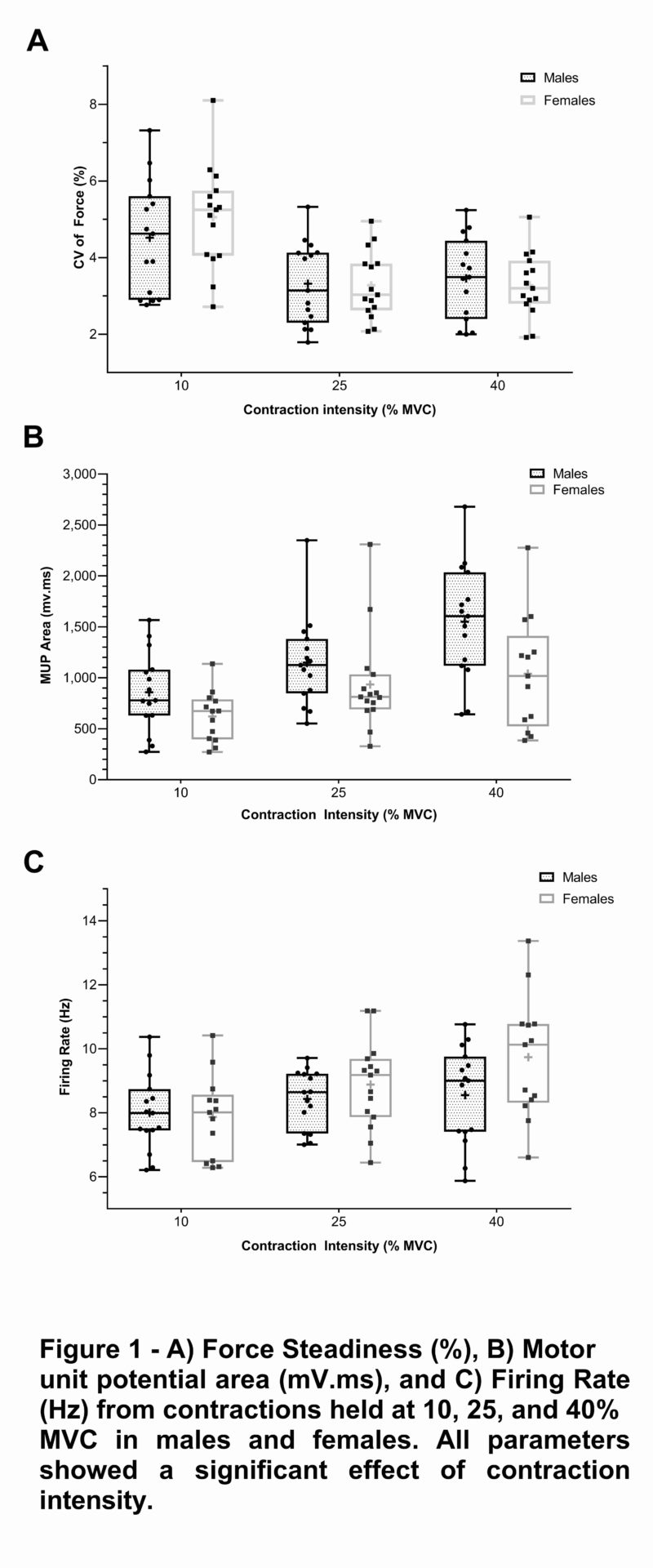The greater decline in force steadiness (FS) observed in older males (Tracy and Enoka 2002), is indicative of a sex-specific attenuation of motor control (Castronovo et al. 2018). There is growing evidence that FS (Jakobi et al. 2018) and recruitment strategies (Nishikawa et al. 2017) in young adults are also sexually dimorphic. Increases in force production of a muscle require the recruitment of additional, progressively larger motor units (MU) and increases in MU firing frequency, and alterations of these strategies may directly influence FS. We hypothesised that any sex-differences found in FS of the knee-extensors would also be observed in recruitment strategies of the vastus lateralis (VL). 30 healthy and recreationally active young adults (Males n =15, Age 22 ± 2 yrs., BMI 25 ±4 and Females n = 15, Age 23 ± 2 yrs., BMI 24 ± 3) were recruited. Muscle cross-sectional area (CSA) was measured using ultrasound. Knee-extensor strength was assessed with isometric maximal voluntary isometric contraction (MVC), and FS was quantified as the coefficient of variation from force applied to targets held at 10%, 25% & 40% MVC for ~12s. Simultaneous intramuscular electromyography provided sampling of individual MUs from the VL. The area of the motor unit potential (MUP) was used as an indicator of MU size and the MU firing rate (FR) calculated from consecutive occurrences of the same MUP (Piasecki et al. 2019). Unpaired t-tests were used to compare MVC and CSA, and 2-way ANOVA performed on individual means of FS, MUP area and FR, with sex and contraction level as factors. Significance was accepted at p<0.05. Knee-extensor MVC was higher in males (589 ± 139 N) than in females (419 ± 120 N, p <0.01). Likewise, VL CSA was significantly larger in males (3,061 ± 1, 054 mm2) compared to females (1,974 ± 348 N, p 0.2). When comparing FS, MUP area, and FR at each intensity (Figure 1), there was no main effect of sex observed in any of the measures (all p > 0.1). There was a main effect of contraction intensity observed in all measures (FS p < 0.0001; MUP p = 0.001; FR p = 0.007). In summary, FS was superior (less deviation) at higher intensities, and MU size and FR increased with increasing contraction intensity. These data confirm previous findings that FS improves with increasing contraction intensity, although we observed no significant difference between sexes, as previously reported (Tracy and Enoka 2002). As expected, in both sexes, the mean size of the recruited MU and MU FR increased with contraction intensity. The lack of a sex-based interaction demonstrates MU recruitment strategies of the VL do not differ between young adults. Our data highlight a lack of rationale for selecting healthy young participants based on sex for neuromuscular studies. Further work is required to elucidate the mechanisms of fluctuating sex-hormones and their influence on neuromuscular function.
Future Physiology 2020 (Virutal) (2020) Proc Physiol Soc 46, PC0153
Poster Communications: Motor unit recruitment strategies of the human vastus lateralis do not differ in healthy males and females
Daniel McCormick1, Jessica Piasecki2, John Gladman1, Paul Greenhaff1, Philip J Atherton1, Mathew Piasecki1
1 MRC Versus Arthritis Centre for Musculoskeletal Ageing Research & NIHR Nottingham BRC, University of Nottingham, Derby, United Kingdom 2 Musculoskeletal Physiology Research Group, Sport, Health and Performance Enhancement Research Centre, School of Science and Technology, Nottingham Trent University, Nottingham, United Kingdom
View other abstracts by:
Where applicable, experiments conform with Society ethical requirements.

